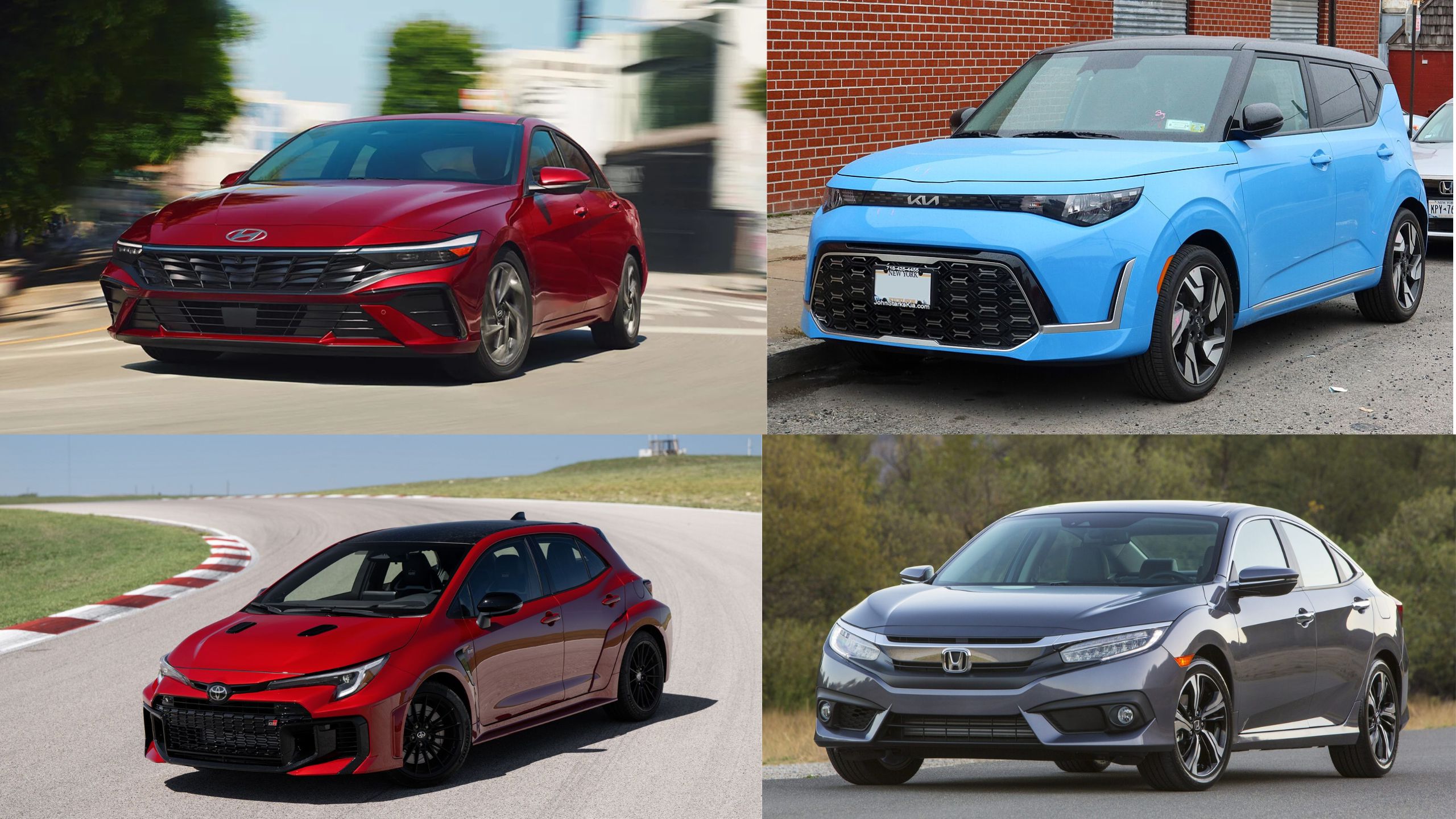Entry-level cars represent the gateway to vehicle ownership for many buyers, but the experience can vary dramatically depending on which model you choose.
While budget-friendly pricing is the common denominator in this segment, some manufacturers have mastered the art of delivering a premium feel without the premium price tag, while others cut corners that are impossible to ignore.
Today’s competitive market has raised the bar for what consumers can expect in affordable vehicles. Thoughtful design touches, quality materials, and attention to refinement can transform an economical purchase into a genuinely satisfying ownership experience.
Conversely, poor execution in these areas can make even the most budget-friendly car feel like a compromise too far. In this guide, we’ll explore five entry-level models that punch well above their weight class, delivering surprisingly upscale experiences that belie their modest price points.
We’ll also examine five models that, despite their practical merits, fall short in creating that coveted premium feel that makes a car truly enjoyable to live with day after day.
5 Entry-Level Cars That Feel Premium
Whether you’re shopping for your first car or looking to maximize value in your next purchase, understanding these distinctions can help you make a more informed decision.
1. Mazda3
The Mazda3 stands as perhaps the most compelling example of premium feel in an affordable package. From the moment you slide into the driver’s seat, it’s clear this isn’t your typical economy car.
Mazda has crafted an interior that genuinely rivals luxury brands, with soft-touch materials covering virtually every surface you regularly interact with.
The minimalist dashboard design, with its driver-focused layout and available 8.8-inch infotainment screen, exudes sophistication rarely found at this price point.
What truly raises the Mazda3 is its driving dynamics. Mazda’s engineers have created a chassis that delivers precise handling and a refined ride quality typically associated with European luxury sedans.
The G-Vectoring Control Plus technology subtly adjusts power delivery and braking through corners, creating a smoother, more connected driving experience that feels meticulously engineered rather than mass-produced.
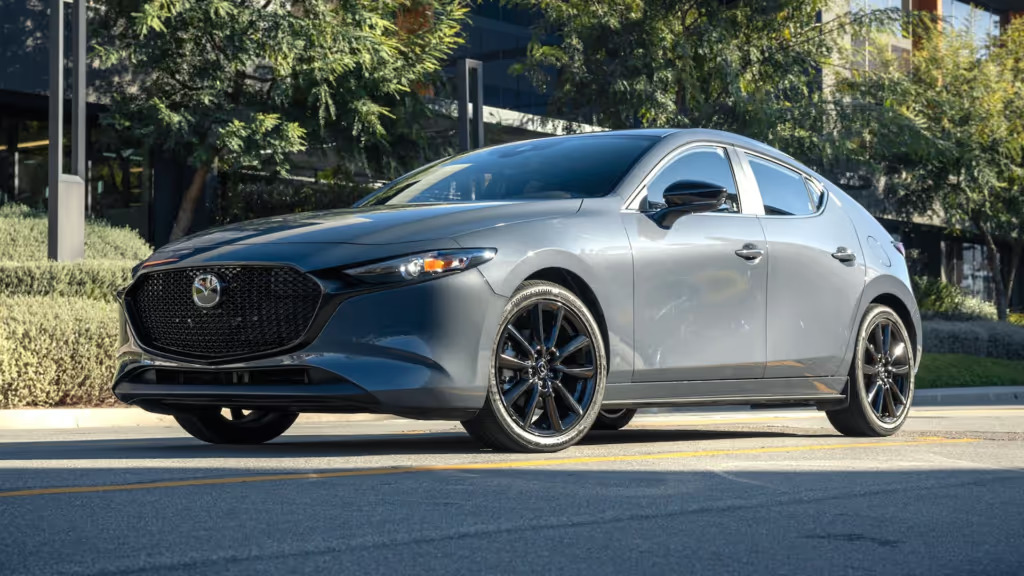
Sound insulation, often the first casualty in budget-conscious vehicles, receives proper attention in the Mazda3.
Highway cruising is remarkably hushed thanks to extensive noise-dampening materials and acoustic glass.
The available premium audio system, tuned specifically for the Mazda3’s cabin acoustics, delivers sound quality that would satisfy audiophiles.
Even the exterior design transcends its class, with flowing lines and careful proportions that give it a sense of motion even when parked.
The attention to detail extends to the satisfying weight of door closures and the precise feel of switchgear, small touches that collectively create an impression of quality that stays with you long after the drive ends.
2. Hyundai Elantra
The latest generation Hyundai Elantra represents a masterclass in affordable luxury, delivering upscale features and design elements typically reserved for vehicles costing thousands more.
Its bold exterior styling with parametric patterns, sharp creases, and jewel-like LED lighting makes a visual statement that defies its entry-level positioning.
Step inside, and the premium impression continues with a cockpit-inspired interior featuring a wraparound dashboard that seamlessly integrates dual 10.25-inch displays on higher trims.
The horizontal layout creates a sense of spaciousness, while thoughtfully placed ambient lighting (available in 64 colors on select models) transforms the nighttime driving experience into something special.
Hyundai hasn’t just focused on aesthetics; the technology integration feels genuinely premium.
The available Digital Key feature allows drivers to use their smartphone as a vehicle key, while wireless Apple CarPlay and Android Auto eliminate cable clutter.
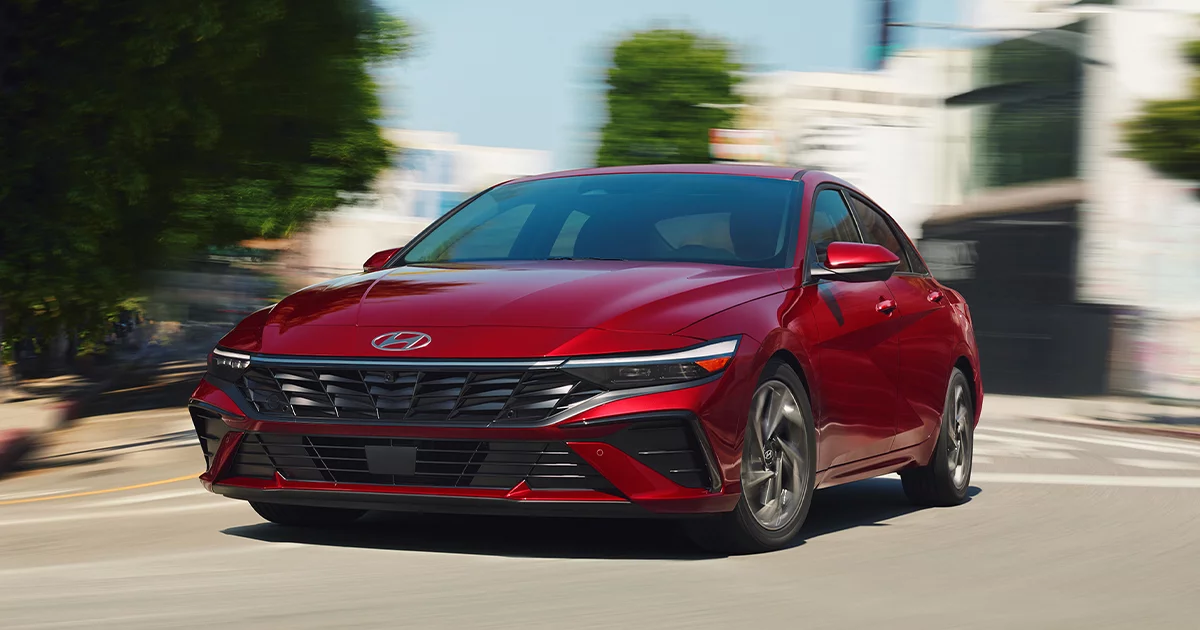
The natural voice recognition system responds to commands with a fluidity that matches luxury vehicles costing twice as much.
What truly sets the Elantra apart is its comprehensive suite of driver assistance features that work with remarkable smoothness.
The Highway Driving Assist, for example, maintains lane centering and adaptive cruise control with a refinement that doesn’t constantly remind you of its budget origins through jerky corrections or false alarms.
Even road noise, traditionally a weakness in compact sedans, is well-managed through strategic sound insulation and suspension tuning that absorbs rather than transmits road imperfections.
Combined with surprisingly comfortable seating and thoughtful details like rear air vents and multiple USB ports, the Elantra delivers daily usability wrapped in an upscale experience.
3. Kia Soul
The Kia Soul may appear unconventional, but beneath its boxy exterior lies an entry-level vehicle that delivers a surprisingly premium experience through thoughtful design and clever engineering.
Rather than attempting to mimic traditional luxury cues, the Soul creates its upscale feel through personality and practical innovation.
The Soul’s interior represents its greatest achievement. The cabin features an open, airy design with impressive headroom and visibility that creates a sense of spaciousness typically lacking in this price segment.
Strategic use of soft-touch materials on frequent contact points steering wheel, armrests, and door panels, raises the tactile experience.
Higher trims offer synthetic leather upholstery that convincingly mimics the real thing while proving more durable.
Kia’s thoughtful approach to technology integration gives the Soul a distinctly premium feel.
The available 10.25-inch touchscreen sits prominently atop the dashboard with crisp graphics and intuitive menus that respond promptly to inputs.
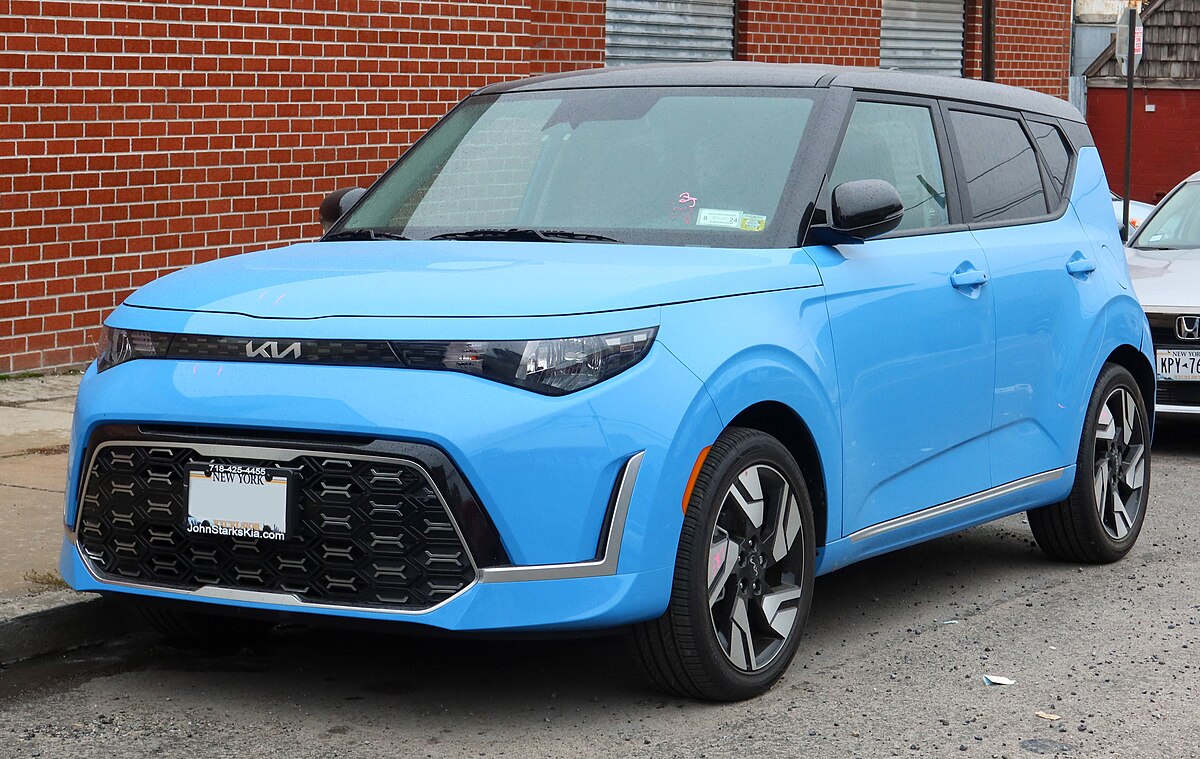
The available Harman Kardon audio system with mood lighting that pulses to the music creates an immersive entertainment experience usually found in luxury vehicles.
The Soul’s driving dynamics surprise with a well-damped suspension that strikes an excellent balance between comfort and control.
Road noise, often excessive in budget-friendly vehicles, is well-managed through acoustic glass and strategic sound insulation.
The powertrain, particularly in turbocharged GT-Line trim, delivers smooth, confident acceleration that belies its economy car roots.
Perhaps most impressive is how the Soul’s packaging maximizes practicality without feeling like a compromise. The upright seating position provides excellent visibility, while the flexible cargo area offers surprising utility.
Small touches like an adjustable cargo floor, multiple USB ports, and an available wireless charging pad demonstrate Kia’s understanding that a premium feel comes not just from aesthetics but from daily usability.
4. Toyota Corolla Hatchback
The Toyota Corolla has long been synonymous with reliable transportation, but the current Corolla Hatchback brings a premium dimension to Toyota’s entry-level offering.
This transformation begins with its striking exterior design, far removed from the appliance-like Corollas of yesteryear, featuring dynamic lines, LED lighting, and a purposeful stance that conveys sporting intentions.
Inside, Toyota has dramatically raised the Corolla’s interior quality.
Soft-touch materials cover the dashboard and door panels, complemented by contrast stitching and tasteful metallic or piano black accents.
The driver-oriented cockpit features well-bolstered front seats that provide surprising comfort during long drives.
Higher trims offer a combination of fabric and synthetic leather that both look upscale and prove durable in daily use.
The Corolla Hatchback’s premium feel extends to its driving dynamics.
Built on Toyota’s TNGA platform, it delivers a solid, planted feel with precise steering and a suspension that absorbs road imperfections without feeling disconnected.
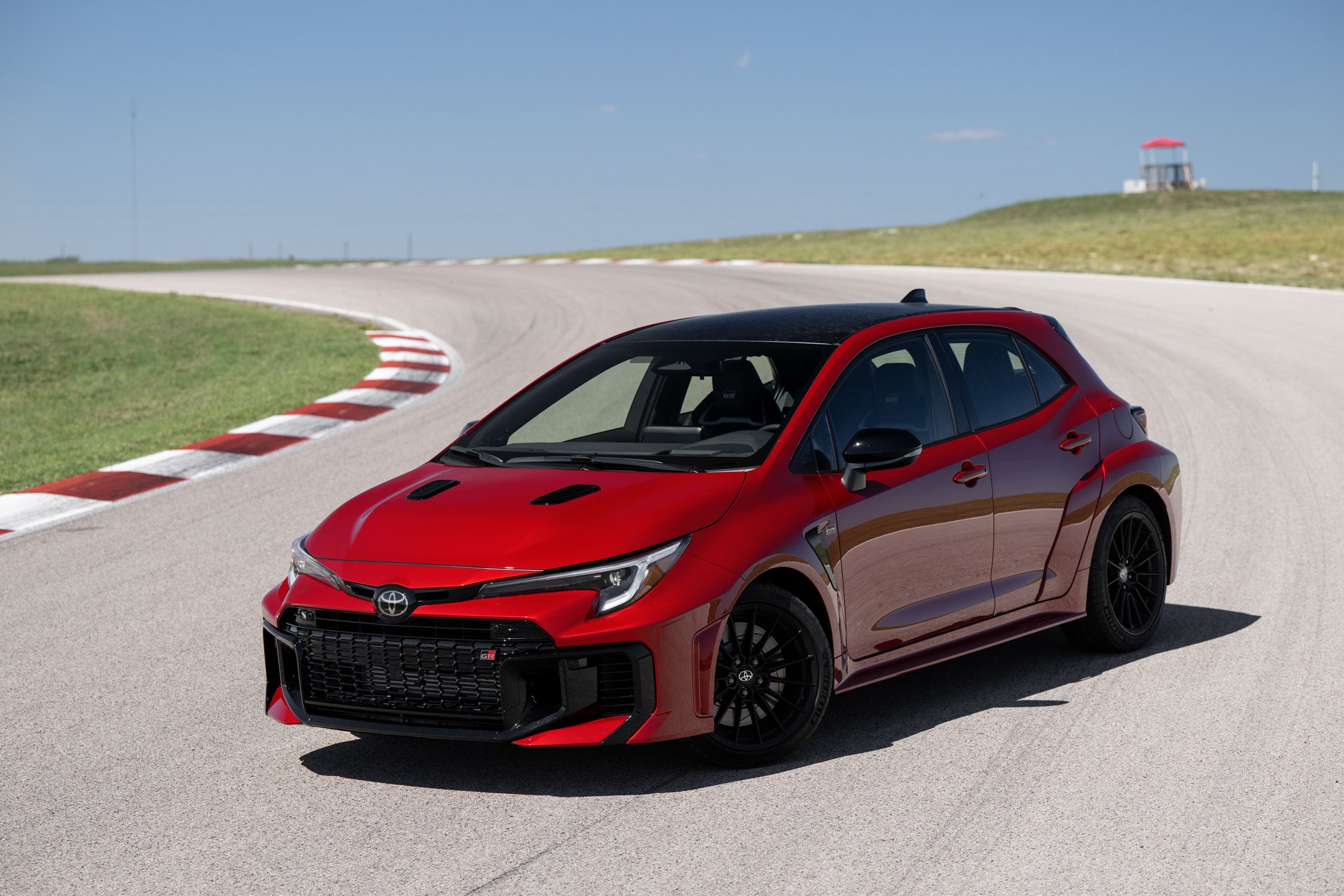
The available Dynamic-Shift CVT includes a physical first gear for improved acceleration feel, a thoughtful engineering solution that eliminates the elastic, unrefined sensation common to many CVT-equipped economy cars.
Toyota hasn’t skimped on technology either. The standard 8-inch touchscreen (with wired or wireless Apple CarPlay and Android Auto) responds quickly to inputs, while the available 7-inch digital instrument cluster provides customizable information displays.
The standard Toyota Safety Sense 3.0 suite operates with a refinement that doesn’t constantly remind you of its presence through false alarms or abrupt interventions.
What truly raises the Corolla Hatchback is its attention to the subtle details that create a premium experience: excellent sound insulation that keeps road and wind noise at bay, doors that close with a solid thunk rather than a tinny clang, and climate controls that operate with precise detents rather than vague movements.
These small refinements collectively create an impression of quality that transcends its entry-level price point.
Also Read: 10 Forgotten Models That Turned Out to Be Reliability Beasts
5. Honda Civic
The Honda Civic represents one of the most remarkable transformations in the entry-level segment, evolving from basic transportation to a vehicle that genuinely challenges premium compacts in both design and execution.
The current generation Civic presents a mature, sophisticated exterior with clean lines and perfect proportions that have abandoned the sometimes polarizing styling of its predecessor.
Step inside, and the Civic’s interior reveals Honda’s renewed focus on quality and design cohesion.
The horizontal dashboard layout, highlighted by a distinctive honeycomb mesh accent that cleverly conceals air vents, creates a modern, uncluttered appearance.
Physical controls for climate functions maintain ease of use, while soft-touch materials cover most surfaces where hands regularly fall.
Even the switchgear operates with a precision that communicates quality through subtle tactile feedback.
The Civic’s technology integration feels particularly premium.
The available 9-inch touchscreen floats above the dashboard with crisp graphics and responsive performance.
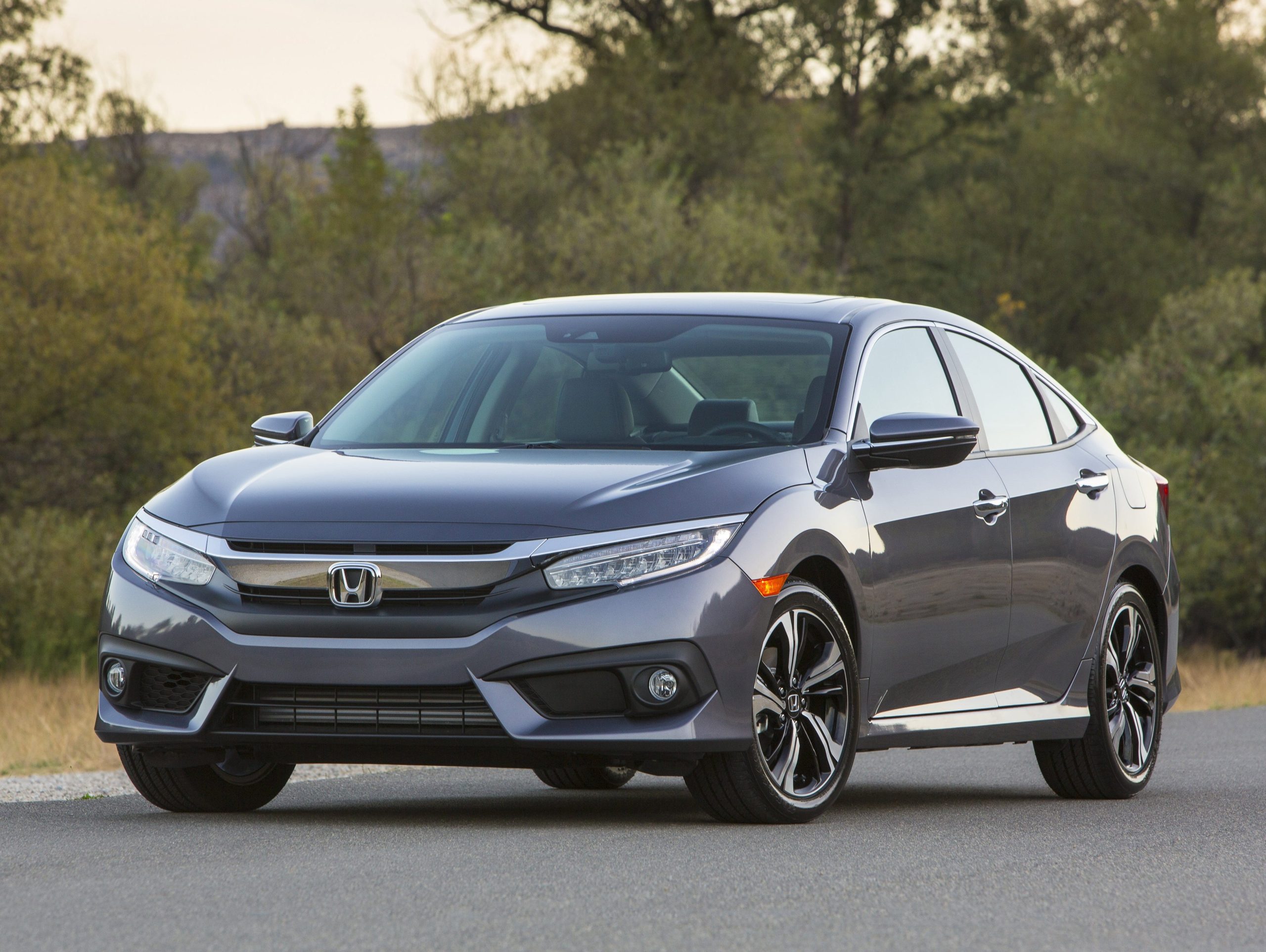
The digital instrument display offers multiple information layouts without overwhelming the driver with unnecessary complexity.
Wireless Apple CarPlay and Android Auto eliminate cable clutter, while the available Bose premium audio system delivers exceptional sound quality, specifically tuned for the Civic’s acoustic environment.
Honda’s engineering prowess is evident in the Civic’s driving dynamics, which strike a remarkable balance between comfort and engagement.
The chassis feels solid and planted at highway speeds, while the suspension absorbs impacts without transmitting harshness into the cabin.
Sound insulation, historically a weakness in entry-level vehicles, receives proper attention, resulting in a quiet interior even at highway speeds.
Perhaps most impressive is how the Civic delivers this premium experience while maintaining the practical virtues that have made it a perennial bestseller.
The spacious interior accommodates passengers comfortably, storage solutions abound throughout the cabin, and fuel efficiency remains excellent.
It’s this combination of premium feel without practical compromises that makes the Civic stand out as an entry-level vehicle that punches well above its weight class.
5 Entry-Level Cars That Feel Cheap
1. Mitsubishi Mirage
The Mitsubishi Mirage serves as perhaps the most striking example of an entry-level vehicle that unabashedly embraces its budget status.
While offering one of the lowest starting prices in the American automotive market, the compromises required to achieve this price point are immediately evident throughout the vehicle.
Interior materials represent the Mirage’s most obvious concession to cost-cutting. Hard, hollow-feeling plastics dominate every surface, with virtually no soft-touch materials to be found.
The dashboard and door panels feel particularly thin and brittle, often emitting creaks and rattles over even minor road imperfections.
The cloth upholstery, while functional, has a coarse texture that feels designed for durability rather than comfort or tactile pleasure.
The Mirage’s driving experience further reinforces its budget positioning.
The tiny three-cylinder engine, while efficient, produces just 78 horsepower, resulting in acceleration that feels labored even in everyday driving scenarios.
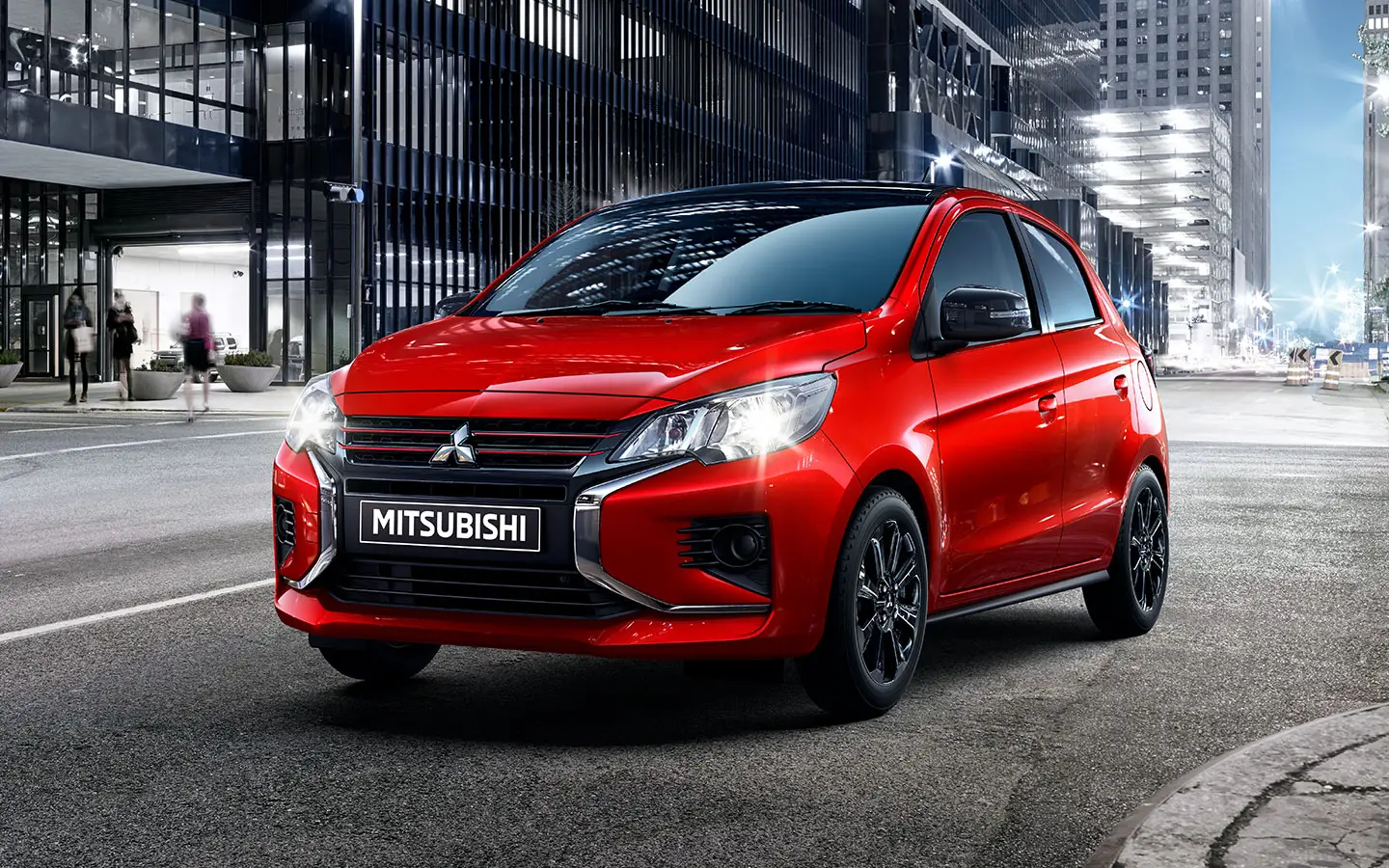
Highway merging and passing maneuvers require significant planning and patience.
The continuously variable transmission exhibits the “rubber band” sensation that economy car CVTs are notorious for, with engine speed often disconnected from actual acceleration.
Road and wind noise infiltrate the cabin with minimal resistance, requiring raised voices for conversation at highway speeds.
The suspension crashes over imperfections rather than absorbing them, transmitting every bump and pothole directly to occupants.
The lightweight structure (under 2,100 pounds) provides little sense of solidity or security when sharing the road with larger vehicles.
While the Mirage offers basic modern amenities like a touchscreen infotainment system with smartphone integration, the execution feels aftermarket rather than integrated, with graphics, response times, and interface design that lag significantly behind competitors.
Even the steering wheel and shift knob touch points used in every drive lack the tactile quality that helps create a sense of value beyond the price tag.
Though the Mirage serves its purpose as affordable transportation, it makes few attempts to disguise its fundamental economy car nature.
2. Chevrolet Spark
The Chevrolet Spark, while charming in its diminutive proportions, consistently reminds drivers and passengers of its budget-focused mission through numerous tell-tale signs of economy car compromises.
Its tiny footprint among the smallest vehicles sold in America translates to an interior that feels cramped even by subcompact standards, with rear seats that are challenging for adult passengers to access and occupy comfortably.
Material quality throughout the cabin speaks clearly to the Spark’s entry-level positioning.
Hard plastics dominate every surface, with a hollow, insubstantial feel when tapped or pressed.
The climate control knobs rotate with little resistance or detent feedback, while door panels sound thin and tinny when closed.
Even the headliner material has a cardboard-like texture that feels selected purely for cost efficiency rather than perceived quality.
The Spark’s powertrain, a modest 98-horsepower four-cylinder engin,e struggles to deliver adequate acceleration, particularly when paired with the optional CVT transmission.
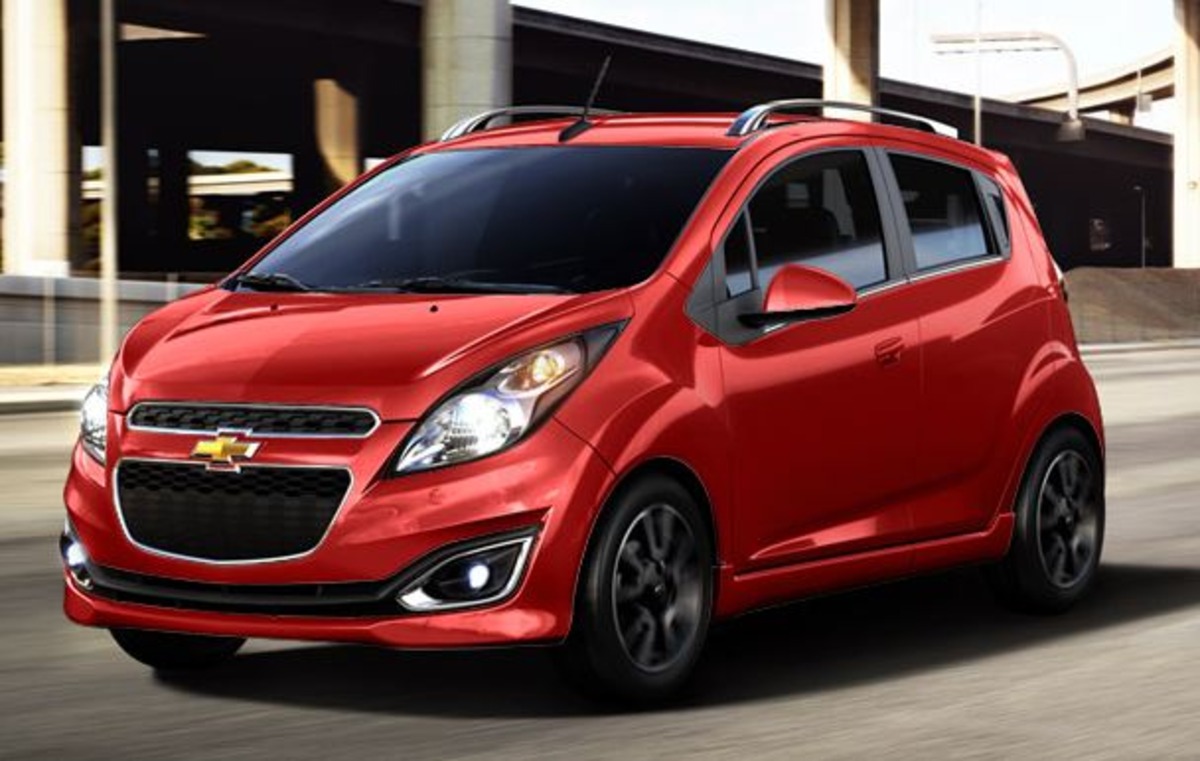
Highway merging requires patience and planning, while maintaining speed on inclines often demands full throttle application, sending engine noise soaring without corresponding increases in velocity.
The tall, narrow body design contributes to notable susceptibility to crosswinds, requiring constant steering corrections during highway driving.
Noise isolation represents another area where the Spark’s budget roots become apparent.
Road and tire noise infiltrate the cabin with minimal resistance, while the engine’s buzzy character becomes intrusive during acceleration.
At highway speeds, wind noise around the A-pillars and side mirrors creates a persistent drone that can make longer journeys fatiguing.
While Chevrolet has attempted to modernize the Spark with available technology features like a touchscreen infotainment system and smartphone integration, the implementation feels tacked-on rather than thoughtfully integrated.
The screen’s positioning, interface responsiveness, and graphics quality lag behind competitors, while the basic four-speaker audio system produces a tinny sound that fails to fill the small cabin effectively.
Despite its affordable price point and city-friendly dimensions, the Spark makes few attempts to disguise the many compromises required to achieve its economy car status.
3. Nissan Versa
The Nissan Versa, despite significant improvements in its latest generation, still exhibits numerous characteristics that betray its position as an economy-focused vehicle.
While the exterior styling has evolved to adopt more contemporary design elements, the cost-cutting measures become apparent upon closer inspection and extended use.
Interior materials represent the most obvious area where the Versa’s budget positioning becomes evident.
While Nissan has added some soft-touch points on higher trims, much of the cabin features hard, hollow-feeling plastics with visible seams and inconsistent panel gaps.
The cloth upholstery, particularly on base models, has a coarse texture that seems selected primarily for durability rather than comfort or aesthetic appeal.
The headliner feels thin and insubstantial, while the carpeting is minimal with exposed metal visible in some footwell areas.
The Versa’s powertrain, a 122-horsepower four-cylinder engine, provides adequate city performance but quickly reveals its limitations during highway merging or passing maneuvers.
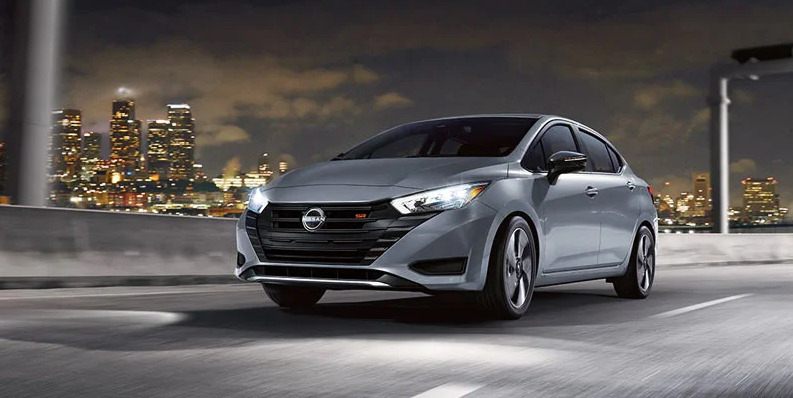
When paired with the available CVT transmission, the engine drones noticeably during acceleration, with the transmission exhibiting the rubber-band sensation common to budget-oriented CVTs.
The throttle response feels non-linear, making smooth acceleration from a stop challenging even for experienced drivers.
Road and wind noise infiltration represents another area where the Versa’s economy car roots become apparent. At highway speeds, tire noise transmits readily into the cabin, while wind rushes around the A-pillars creates a constant background drone.
The suspension, while handling normal road imperfections adequately, transmits sharp impacts directly to occupants with little dampening, creating a sometimes choppy ride quality on rougher surfaces.
Though Nissan equips the Versa with modern technology features like a touchscreen infotainment system and available driver assistance features, the implementation often feels like an afterthought rather than seamlessly integrated.
The graphics appear dated compared to competitors, with response times that occasionally lag behind inputs. The standard audio system produces thin sound quality that struggles to overcome the ambient noise level in the cabin.
While the Versa provides reliable transportation at an accessible price point, it makes little attempt to disguise its fundamental economy car compromises.
4. Hyundai Venue
The Hyundai Venue, despite its trendy crossover styling and youthful marketing, reveals its budget-oriented nature through numerous compromises that become increasingly apparent with extended use.
While Hyundai has made commendable efforts to inject personality into this entry-level offering, the underlying economics of producing a vehicle at this price point inevitably shine through.
Interior material quality serves as perhaps the most obvious indicator of the Venue’s position in Hyundai’s lineup.
Hard plastics dominate virtually every surface, with a particularly hollow, insubstantial feel on the door panels and lower dashboard areas.
Though designers have attempted to create visual interest through patterns and textures, the tactile experience remains firmly economy-class.
The cloth upholstery, while durable, lacks the plushness found in Hyundai’s slightly more expensive models, and the minimal padding in the seats becomes apparent during longer drives.
The Venue’s driving dynamics further reveal its budget underpinnings.
The 121-horsepower four-cylinder engine struggles under acceleration, particularly when carrying passengers or climbing hills.
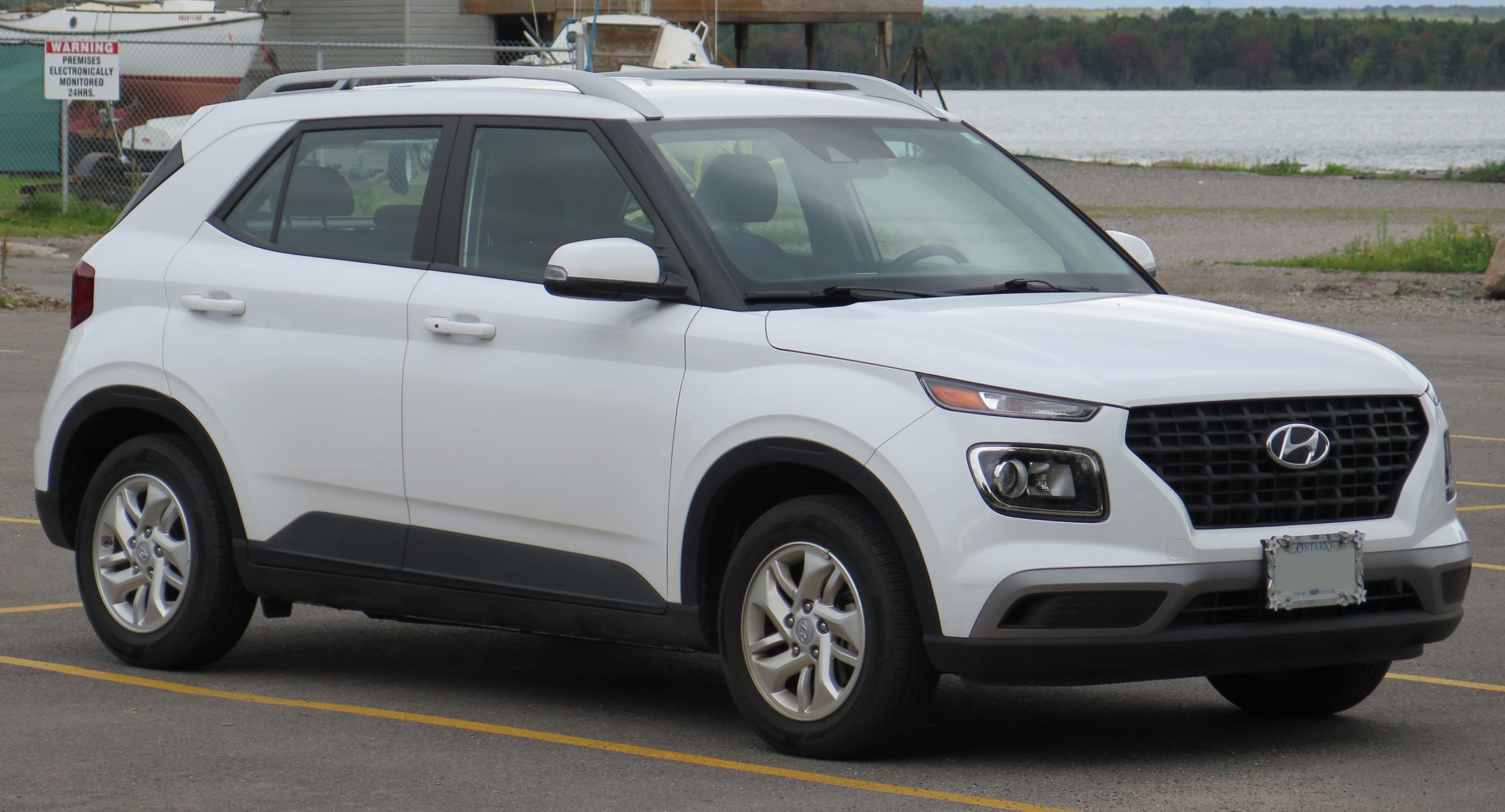
The available Intelligent Variable Transmission (IVT), Hyundai’s version of a CVT, exhibits the characteristic drone and rubber-band sensation common to economy-focused continuously variable transmissions.
The lightweight body structure (under 2,700 pounds) provides little sense of substantiality, with noticeable body lean during cornering and susceptibility to crosswinds on highways.
Road and wind noise infiltration remains a persistent reminder of the Venue’s economy car roots.
Highway cruising generates a constant background drone that makes conversation or music appreciation more challenging than in vehicles with more comprehensive sound insulation.
The suspension, while generally compliant over smooth surfaces, crashes through potholes and transmits road imperfections directly to occupants rather than absorbing them.
Despite Hyundai’s efforts to include modern technology like an 8-inch touchscreen with smartphone integration, the implementation often feels more like a checklist item than a seamlessly integrated feature.
The standard four-speaker audio system produces a thin, tinny sound that struggles to fill the cabin effectively.
Even the climate control system, with its basic three-dial layout, operates with a lightweight feel that lacks the satisfying precision found in Hyundai’s more premium offerings.
While the Venue serves its purpose as affordable transportation with crossover styling cues, it makes little attempt to disguise the fundamental compromises required to achieve its entry-level price point.
5. Kia Rio
The Kia Rio, while representing a solid value proposition in the subcompact segment, contains numerous indicators of its economy car roots that become increasingly apparent through daily use.
Though Kia has improved the Rio’s styling with each generation, the underlying compromises necessary to achieve its accessible price point remain evident throughout the vehicle.
Interior material quality serves as the most immediate reminder of the Rio’s budget positioning. Hard, somewhat hollow-feeling plastics cover most surfaces, with minimal soft-touch materials even on common contact points.
The dashboard texture, while designed to appear more premium than it feels, cannot disguise its fundamental inexpensive nature.
Door panels sound thin when closed, lacking the solid thunk associated with more substantial vehicles. The cloth upholstery, particularly on base models, has a somewhat coarse texture that prioritizes durability over comfort or tactile pleasure.
The Rio’s powertrain, a 120-horsepower four-cylinder engine, provides adequate city performance but quickly reveals its limitations during highway driving scenarios.
Acceleration feels labored, particularly when carrying passengers or climbing grades, requiring deep throttle inputs that send the engine into its buzzy upper RPM range.
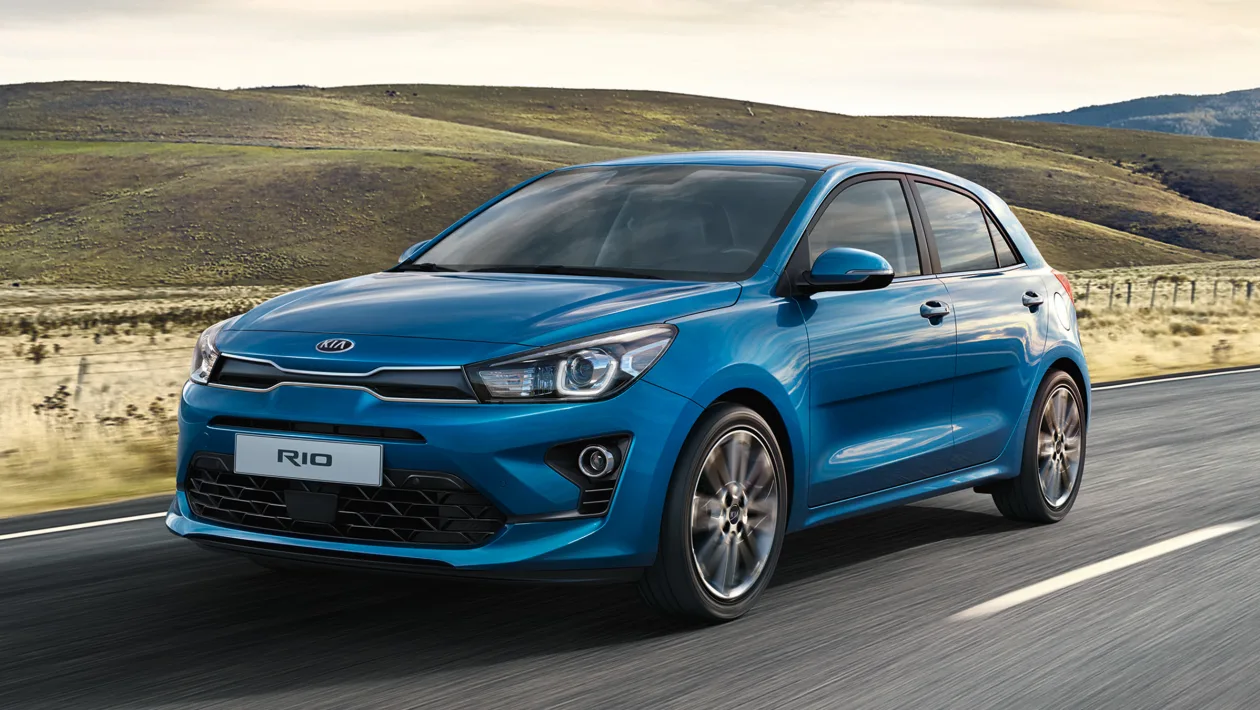
The continuously variable automatic transmission exhibits the characteristic rubber-band sensation common to economy-focused CVTs, with engine speed often seeming disconnected from actual acceleration progress.
Noise isolation represents another area where the Rio’s economy car compromises become apparent.
Road and tire noise readily infiltrate the cabin, creating a persistent background drone at highway speeds.
The minimal sound insulation allows engine noise to become intrusive during acceleration, while the wind rush around the A-pillars becomes increasingly noticeable as speeds increase.
The lightweight body structure (under 2,800 pounds) provides little sense of solidity or insulation from the outside environment.
Though Kia equips the Rio with modern technology features like an available touchscreen infotainment system with smartphone integration, the implementation sometimes feels more like a checklist item than a thoughtfully integrated feature.
The standard four-speaker audio system produces thin sound quality that struggles to overcome the ambient noise level in the cabin.
Even seemingly simple components like the turn signal stalk and window switches operate with a lightweight feel that lacks the precise detents and satisfying feedback found in more premium vehicles.
While the Rio delivers reliable, efficient transportation at an accessible price point, it makes few attempts to disguise its fundamental economy car nature.
Also Read: 10 Brands With Proven Powertrain Excellence That You Should Know

